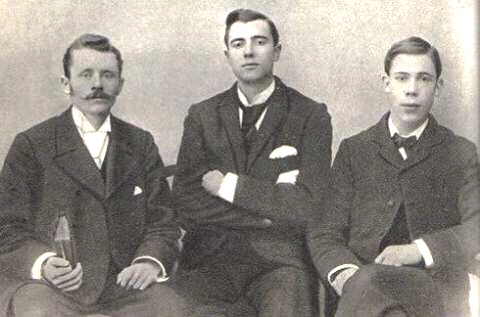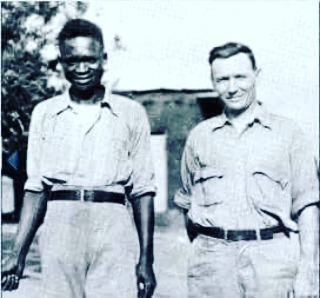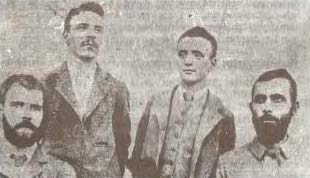by E. A. Adeyemi | ECWA Ilorin district church council is a district among 82 districts of ECWA worldwide, it was founded in 1973 out of former Yoruba DCC, four DCCs has been Inaugurated out in Ilorin district church council. The DCCs include Omu-Aran DCC established in 1992, Igbaja DCC established in 1998, Oro ago DCC established in 2000, and Fate-Tanke DCC established in the year 2015. Currently Ilorin DCC has about 7 local church council (LCC). The Ilorin district church council has its secretariat located in Ilorin, along Ahmadu Bello Avenue GRA, Ilorin.
BEHOLD! I am doing a new thing. Isaiah 43:19-21
The Pioneers
On 7th April 1946 a small congregation of seven people started an S. I. M. Church in Ilorin. That humble beginning grew into what is today the ECWA Churches in the city. The population has risen from over 7,000 worshippers in ten different locations in 1995 to approximately 21,000 in 2019. There are also many out-station churches established in villages surrounding the town by the church. The name Sudan Interior Mission (S. I. M.) was adopted by pioneers of a Christian Mission whose sole objective was to open Sudan, the land of the blacks from the West to the East of Africa between the Equator and Sahara Desert, to the Gospel of Our Lord and Savior Jesus Christ.

A month after landing in Lagos, Bingham wrote a letter to Mr. J. C. Hindle of Southport, England and said “… we have decided to call the mission, The Sudan Interior Mission.”
There were times, however, when it was called by other names. In 1901 it was known as the African Industrial Mission. In 1905 it became known as African Evangelistic Mission. The name was again changed to the Sudan United Mission in 1906. The original name, the Sudan Interior Mission was reverted to by 1907. Reasons for these frequent changes in the name within seven years are not clear. The aim, however, remained unchanged at any time; the sixty million lives in the ‘dark Sudan‘ must be reached for Christ. This aim was resolutely pursued. The degree of its achievement was quite remarkable. By 1954 a move had been made to indigenize the mission. The name Evangelical Churches of West Africa (ECWA) was adopted.
The name reflects the evangelical nature of the Mission, while the vision that the work would extend to other countries in West Africa inspired its authors to extend its scope beyond Nigerian borders.
The story of the coming of the Sudan Interior Mission into Nigeria has been told elsewhere, and it is hoped that it will be further told by author in another work soon. Therefore only a few words need be written in that regard here.
It all started in 1893 when Mrs. Gowans, the mother or a Canadian young man, Walter Gowans, saw the vision of Sudan as a dark area waiting for spiritual illumination and decided that her son, Walter Gowans, should be used by God for that purpose. She got two more willing people in this regard: Thomas Kent and Rowland Victor Bingham. The three landed in Lagos on December 4, 1893. They were warned by the Methodist Missionaries of the dangers ahead, but they remained undaunted. Bingham stayed in Lagos to get supplies from home and maintain contact with friends, while the remaining two moved on to the Interior.

Gowans soon died in Girku near Zaria on November 17, 1894. He was buried in a cornfield by his servant. Tom Kent was taken ill with malaria and also died at Bida on December 8, 1894. Bingham returned home. Mission impossible? Far from that, Bingham came back to Africa in 1900. He was again dissuaded by missionaries and by the ‘devil‘ himself from making another attempt to the Sudan. He was ill again and, on medical advice, ordered home. The two companions who had promised to carry on while he was away, could not make good on their promises and they left Lagos for home by the next boat. Mission impossible? Far from it.

Bingham got three other willing missionaries, E. A. Anthony, Charles Robinson and Albert Taylor who were ready to make the third attempt while another, A. W. Banfields joined the party later. With the help of Sir Frederick Lugard who gave them a safe passage they got to Pategi to build the first mission home in Africa in 1901. There, Dr. Andrew P. Stirret also worked as a Missionary and doctor but within two years three of the four missionaries – Anthony, Robinson and Taylor had died leaving only Banfield.
In 1904 the second SIM station opened at Wushishi was headed by Mr. F. E. Hein. In 1908 the third SIM station was opened at Egbe under the supervision of Tommie Titcombe. In 1912 another station was opened at Oro-Ago by Guy Playfair. In 1915 the Mission at Agunjin was started.
Ilorin fell into the northern protectorate and schools were established with mix of Islamic and Western education. Although Christianity was not permitted in Ilorin when it was first introduced in 1917 with the caveat that churches and mission schools should operate at the outskirts. After independence in 1960, Western schools were established and grew side by side with the mission schools. In the Western schools, Yoruba, Arabic and english languages were in the curriculum.
From Agunjin the SIM Missionary work spread to most Igbomina villages. Although progress was very slow, the Mission at Agunjin later became the nucleus of SIM expansion into Igbominaland. Understandably, Ilorin remained untouched by the mission’s efforts until the early part of 1940s. The Islamic adherents in the town jealously guarded against any outside influence, particularly from missionaries, on the religion. The colonial government, in line with official policy in this regard would not allow the missionaries to operate so freely in a provincial capital and at the headquarters of the Emir. By 1942, however, the necessity to have a mission station where missionaries going to Igbomina and Yagba towns would receive their supplies became quite obvious.
All missionaries passing through Ilorin had made use of a building belonging to the Church Missionary Society which was formerly occupied by Bishop Smith. With the departure of Bishop Smith, the house was used by all missionaries as a Rest House. That building became inadequate for the SIM Missionaries whose number had grown to the extent that by 1943 they had been operating seven European Staffed stations that depended on Ilorin for supplies and transport facilities. It became necessary for the Mission to apply for certificate of occupancy for land to build a Rest House and accommodation for a resident transport agent in Ilorin.
This was granted in 1943 and work began on it in 1944. Elder R. B. Buremoh was the main contractor, the Missionaries kept strictly to the purposes the buildings were put up for as contained on the certificate of occupancy. No attempt was made to establish a local SIM church until 1946 when the move was made by Rev. C. P. Jenson.
ECWA Church in Ilorin
The ECWA Church in Ilorin is administered in line with the general practice of the denomination in Nigeria. In ECWA, the basic unit of authority is the Local Church Board (L.C.B.). There, the Board of Elders is the highest authority in the Local Church. The Board is headed by the pastor in-charge who is its Chairman.
The church secretary keeps the records of the church and receives as well as sends all correspondence matters on behalf of the church. He makes announcements on Sundays and coordinates the various committees and Fellowships in the Church. At the First ECWA Church in Ilorin, the same person had performed all these duties as well as served as the recorder of the minutes of Elders meetings, the Church Secretary performed both administrative and secretarial duties for the church.
Each Elder is also assigned a specific portfolio and represents the Elders in a specific committee or fellowship. Below the Elders are the executives of various committees’ fellowship and church groups. Below them are of course the members of the congregation.
The Hierarchy of the Church Organization
From the L. C.B. the hierarchy of the church organization is to the Local Church Council (L. C. C.) headed by the Local overseer (L.O.). The L. C. C. is in tum responsible to the District Church Council (D. C. C.) under a chairman and an executive secretary. The Council takes care of allocation of ministers to various churches. It is the highest authority in the District. It is responsible to the General Church Council (G. C. C.), the headquarters of which is at Jos. The GCC is headed by the ECWA President. There is a General Secretary and Assistant Secretary. ECWA has the following eight Departments:
- Christian Education Department
- Education Department
- The services to International Missionary Department
- The ECWA Production Limited (EPL)
- The ECWA Rural Development Limited (ERDL)
- The Medical Department
- Radio Ministry Department (ELWA)
- Mission Department (EMS)
These departments are directly responsible to the Board Constituted over them by the ECWA Executive. So, in this hierarchy, policies come from the GCC to the DCC to the LCC to the LCB. From the LCB orders are usually given through the executives of various committees and fellowships to the members of the congregation.
In Ilorin, all the ECWA Churches agreed in 1985 to be holding joint Elders’ meetings quarterly. The first of such meetings was held on April 26th 1985 at the first ECWA Church Ilorin. The second meeting was held at the second ECWA Church, Amilegbe on 30th August 1985 while the third came up on 13th December 1985. Since then it had been held regularly in rotation among the churches. Matters affecting each church are usually discussed in the meeting.
The fellowship enjoyed among elders from various churches makes the meetings a worth-while exercise. Moreover, plans for establishing new churches are discussed and executed through deliberations in the meetings. It was a result of the unifying efforts of Reverend S. A. Fatoye that the joint meetings came into being.
Earlier in 1983, The ECWA Day was jointly celebrated by all ECWA Churches in Ilorin. That first joint service to mark ECWA day was held at the 1st ECWA Church Ilorin on 29th May 1983. Since then it had become an annual event.
Bibliographic information
Title: From seven to seven thousand: the story of the birth and growth of SIM/ECWA church in Ilorin, 1946-1995
Author: E. A. Adeyemi
Publisher: Okinbaloye Commercial Press, 1995
ISBN: 9783273248, 9789783273245
Length: 163 pages
Subjects: Missions, SIM, ECWA, Nigeria
E. A. Adeyemi is a historian, educator and a writer. He had his B.A. in History and Graduate Certificate in Education from the Ahmadu Bello University, Zaria in 1973. Dr. Adeyemi also got his M.A. and Ph.D. in History from the University of Ilorin. He has more than 35 years of research experience in history of Igbomina, including the history of Churches in those areas. Some of his publications include, Moving from Curse to Blessing 1981 and co-author of the Effects of Spacing and Component Crops Population on Seedling Establishment in four Cocoa/ Kola/ Citrus Intercrop in 2015.
He has a wide range of experience in teaching history at both secondary school and post-secondary levels. Dr. Adeyemi is a Senior Principal Lecturer and Head of Department of History at the Kwara State College of Education in Ilorin.



